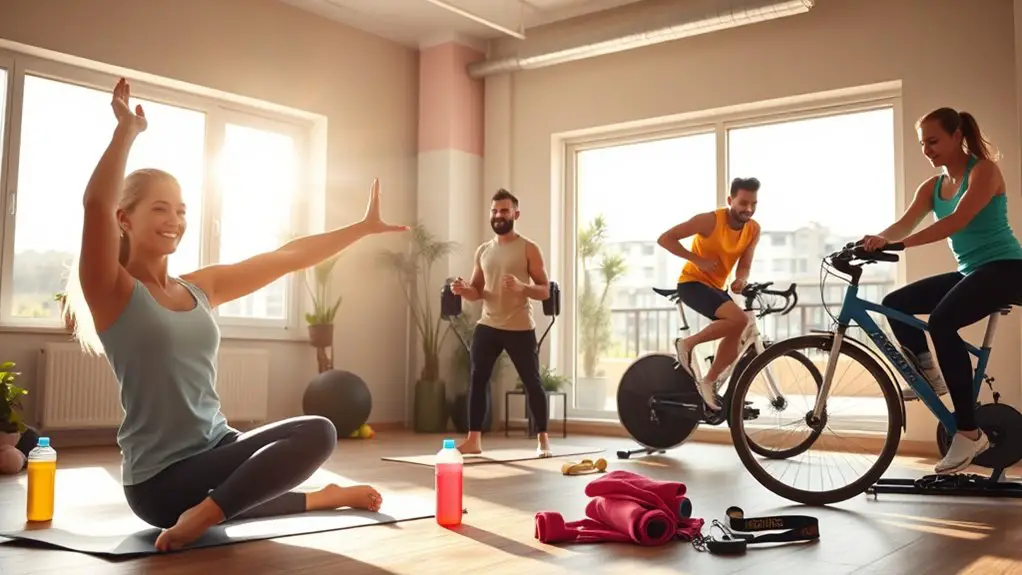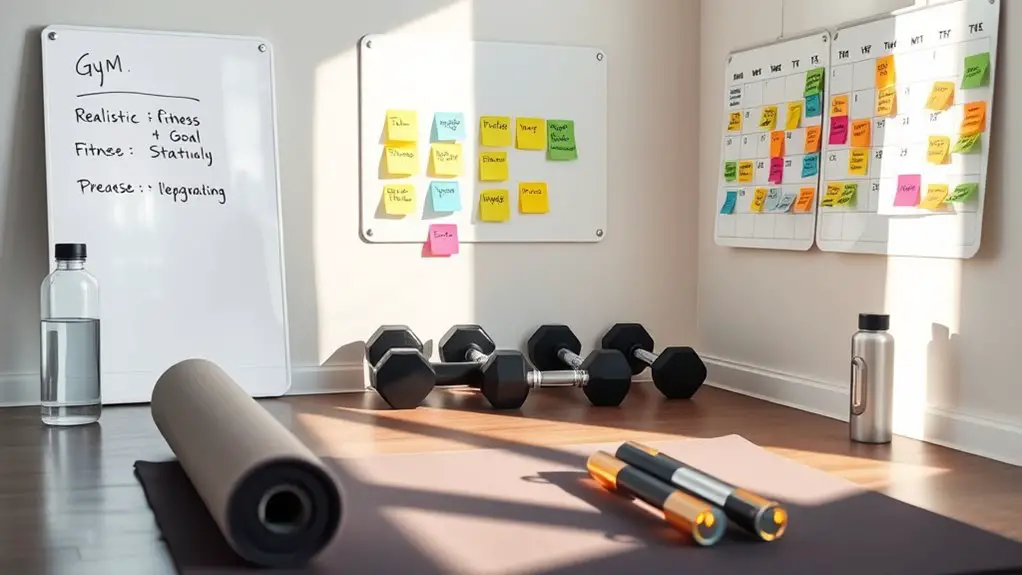How to Avoid Gym Burnout and Stay Consistent

To avoid gym burnout and stay consistent, set realistic goals and track your progress. Mix up your routine to keep it enjoyable, and don’t forget to schedule regular rest days. Find a workout buddy for support and motivation, and listen to your body’s needs to prevent overtraining. Stay hydrated and nourished to fuel your workouts. Celebrate small wins along the way to stay motivated. Discover even more strategies to keep your fitness journey exciting and sustainable.
Set Realistic Goals

When you set realistic goals for your fitness journey, you’re more likely to stay motivated and avoid burnout. It’s essential to practice effective goal setting that aligns with your current fitness level and lifestyle. Instead of aiming for drastic changes overnight, focus on small, achievable milestones. This could mean committing to three workout sessions a week or gradually increasing your workout duration. Remember that consistent effort towards goals can indicate potential progress in your journey.
Mix Up Your Routine
If you’re feeling stuck in your fitness routine, mixing things up can reignite your motivation. Try new workouts, change your environment, or even incorporate fun activities that get you moving. These small adjustments can make a big difference in keeping your gym experience fresh and exciting. Additionally, consider adding skipping rope to your routine, as it serves as an excellent full-body workout that engages multiple muscle groups.
Try New Workouts
To keep your motivation high, trying new workouts can be a game changer. Mixing up your routine not only keeps things fresh but also allows you to discover what you truly enjoy. Whether it’s outdoor activities like hiking or biking, or engaging in virtual classes that fit your schedule, variety is key.
Here’s a quick look at some workout options:
| Activity Type | Safety Tips | Benefits |
|---|---|---|
| Outdoor Activities | Stay hydrated, wear proper gear | Boosts mood, vitamin D boost |
| Virtual Classes | Clear space, check equipment | Flexibility, expert guidance |
| Group Classes | Follow instructor’s advice | Social interaction, motivation |
| Home Workouts | Use proper form, start slow | Convenience, cost-effective |
Try something new this week, and you might find your next favorite workout!
Change Workout Environment
Changing your workout environment can breathe new life into your fitness routine. If you’re feeling stuck in a gym ambiance that doesn’t inspire you, consider exploring different spaces for your workouts. Outdoor workouts not only provide fresh air but also a change of scenery that can motivate you. Here are a few ideas to mix up your routine:
- Try a park: Utilize nature trails or open spaces for running, yoga, or bodyweight exercises.
- Join a class: Look for local fitness classes at community centers or outdoor venues.
- Work out at home: Create a dedicated space for your workouts, free from distractions.
- Visit a new gym: Changing gyms can introduce you to different equipment and training styles.
Embrace the change!
Incorporate Fun Activities
Incorporating fun activities into your fitness routine can reignite your passion for working out. Instead of dreading the gym, consider exploring dance classes, engaging in team sports, or going on outdoor adventures. These playful workouts not only keep you active but also make exercising enjoyable.
| Activity Type | Examples | Benefits |
|---|---|---|
| Dance Classes | Zumba, Ballet | Improves coordination |
| Outdoor Adventures | Hiking, Biking | Connects with nature |
| Team Sports | Soccer, Volleyball | Builds camaraderie |
Adding fitness games or recreational activities can challenge you in new ways. By mixing in these fun challenges, you’ll stay consistent and motivated while prioritizing safety and well-being.
Find a Workout Buddy
Having a workout buddy can make all the difference when it comes to staying motivated and avoiding gym burnout. It’s not just about having someone to share the experience with; it’s also about workout accountability and social motivation. A buddy can help keep you on track and make exercising more enjoyable. Here are a few benefits of finding a workout partner:
- Increased accountability: You’re less likely to skip a workout when someone’s counting on you.
- Shared goals: You can motivate each other to reach personal fitness milestones.
- Safety in numbers: Exercising with a buddy can enhance safety, especially during outdoor activities.
- Fun factor: Having someone to share laughs with makes workouts feel less like a chore.
Schedule Rest Days

Scheduling rest days is essential for your recovery and overall progress. It’s important to plan these days into your routine and listen to your body’s signals. Ignoring the need for rest can lead to burnout and hinder your fitness goals.
Importance of Recovery Time
While you might feel tempted to push through every workout without a break, recognizing the importance of recovery time is essential for long-term success. Taking time to recover not only prevents injuries but also enhances your overall performance. Here are some effective recovery techniques you can incorporate:
- Active recovery: Engage in low-intensity activities like walking or yoga to keep your body moving.
- Hydration: Drink plenty of water to help your muscles recover and stay energized.
- Nutrition: Fuel your body with nutritious foods to aid in muscle repair.
- Sleep: Prioritize quality sleep to allow your body to heal and rejuvenate.
Planning Your Rest Days
Recovery time is just as important as your workout routine, and planning your rest days effectively can help you maintain motivation and prevent burnout. To guarantee effective recovery, consider incorporating rest day strategies into your weekly schedule. Aim for at least one to two rest days each week, depending on your workout intensity. You might also want to alternate between active recovery days, like light walking or stretching, and complete rest days. This balance allows your body to repair itself while keeping you engaged in your fitness journey. Make your rest days enjoyable—catch up on hobbies, spend time with friends, or simply relax. Prioritizing rest fosters long-term consistency and helps you stay safe while achieving your fitness goals.
Listening to Your Body
When you tune into your body’s signals, you can better determine when to take a rest day. Building body awareness is vital for your long-term fitness journey. Ignoring physical signals can lead to burnout or injury, so listen closely. Here are some signs you might need a break:
- Persistent fatigue or low energy
- Unusual muscle soreness or joint pain
- Decreased performance or motivation
- Difficulty sleeping or increased stress
Taking time off isn’t a setback; it’s an important part of your routine. Prioritizing rest days allows your body to recover and adapt, ultimately enhancing your performance. Remember, staying consistent means respecting what your body needs. Listen up, and don’t hesitate to take that much-needed break!
Listen to Your Body

How can you truly gauge your limits in the gym? It starts with listening to your body. Your body sends signals—like fatigue, soreness, or even a sharp pain—that indicate when you need to slow down or take a break. Ignoring these signals can lead to serious injuries and burnout.
Developing mental awareness is essential. Pay attention to how you feel during and after your workouts. If you notice a consistent sense of exhaustion or discomfort, it might be time to reassess your routine. Remember, it’s okay to modify your workouts or take rest days. Prioritizing recovery helps you stay consistent and avoid the dreaded burnout. Proper form is vital to avoid injury, even without soreness.
Trust your instincts; your body knows what it needs. By tuning into these body signals and being mindful, you’ll create a sustainable fitness journey tailored to your unique capabilities and limits.
Track Your Progress
Tracking your progress is essential for staying motivated and avoiding gym burnout. By implementing progress tracking in your routine, you can see how far you’ve come and keep your goals clear. Setting measurable goals helps you stay focused and makes it easier to adjust your workouts when needed. Here are some effective ways to track your progress:
Tracking your progress keeps you motivated and helps clarify your goals, making it easier to adjust your workouts.
- Keep a workout journal: Record your exercises, sets, and reps to visualize improvements.
- Use fitness apps: Many apps can help you log workouts and track your performance over time.
- Take progress photos: Visual reminders of your journey can boost motivation and reveal changes you might not notice day-to-day.
- Set regular check-ins: Evaluate your goals monthly or bi-weekly to see if they need adjustments. Additionally, understanding your daily caloric intake can help you tailor your nutrition to support your fitness goals.
Celebrate Small Wins
Celebrating small wins is essential for maintaining motivation and preventing gym burnout. Acknowledging your progress, no matter how minor, can provide the positive reinforcement you need to keep going. Perhaps you lifted slightly heavier weights, completed an extra set, or simply made it to the gym more consistently. Each milestone, big or small, deserves recognition.
Take a moment to celebrate these achievements. Share your success with friends or reward yourself with a treat that aligns with your fitness goals. This practice reinforces your commitment and reminds you of the effort you’ve put in. When you focus on celebrating milestones, you create a more enjoyable experience that keeps you engaged. Additionally, improving cardiovascular fitness through activities like skipping can further enhance your overall performance and motivation.
Stay Hydrated and Nourished
Recognizing your achievements can boost your motivation, but maintaining that momentum also hinges on keeping your body fueled and hydrated. To avoid burnout, focus on your hydration and nutritional balance. Here are some hydration tips to help you stay on track:
- Drink water throughout the day: Aim for at least 8 cups daily, adjusting based on your activity level.
- Snack smart: Choose nutrient-dense snacks like nuts, fruits, or yogurt to fuel your workouts.
- Plan balanced meals: Incorporate proteins, healthy fats, and whole grains to support recovery and energy.
- Listen to your body: Pay attention to thirst cues and eat when you’re hungry to maintain energy levels. Additionally, consider showering before workouts to enhance your overall gym experience and freshness.
Focus on Enjoyment
Finding enjoyment in your workouts is essential for long-term success, and it can make all the difference in preventing burnout. When you focus on fun workouts, you’re more likely to stick with your routine. Try different activities that you genuinely enjoy, whether it’s dancing, cycling, or hiking. These joyful movements not only keep you engaged but also help reduce stress and improve your mood.
Incorporating effective cardio workouts like skipping rope can also add variety and excitement to your fitness regimen. Listen to your body and choose exercises that feel good; this way, you’ll associate your fitness journey with positive experiences. Don’t hesitate to switch things up; variety can keep your motivation high. Invite friends to join you for a social aspect, making your workouts feel less like a chore and more like a fun outing. Remember, finding what you love is key to creating a sustainable fitness routine, ensuring you stay consistent without feeling overwhelmed. Embrace the joy in movement!
Seek Professional Guidance
When you’re feeling stuck in your routine, seeking professional guidance can make a huge difference. Personal trainers can tailor workouts to your needs, while group classes offer motivation and camaraderie. Both options can help you stay engaged and excited about your fitness journey. Additionally, working with a personal trainer can provide customized workout plans that enhance effectiveness and help you achieve your fitness goals.
Benefits of Personal Trainers
One key advantage of hiring a personal trainer is the tailored guidance they provide. With individualized coaching, you can guarantee your workouts are safe and effective. Here are some personal trainer benefits that can boost your gym experience:
- Customized Workout Plans: Trainers design a program that fits your fitness level and goals.
- Proper Technique Instruction: They teach you how to perform exercises correctly, reducing the risk of injury.
- Motivation and Accountability: Having someone by your side encourages you to stay committed and push your limits.
- Progress Tracking: Personal trainers help monitor your improvements, guaranteeing you’re on the right path.
Group Class Advantages
While personal training offers individualized focus, group classes provide a unique blend of community support and professional guidance that can enhance your fitness journey. The group dynamics foster a fitness community that encourages you to stay committed. You’ll find social motivation in shared experiences, inspiring you to push past your limits. With accountability partners beside you, it’s easier to stay on track and reach your goals. The group energy can elevate your workouts, making them more enjoyable and less monotonous. Plus, with instructor guidance, you’ll learn proper techniques while exploring varied routines that keep things fresh. This combination not only guarantees safety but also builds a supportive environment that helps you avoid burnout and maintain consistency.
Frequently Asked Questions
How Often Should I Change My Workout Routine?
You should consider changing your workout routine every 4 to 6 weeks to keep things fresh and maintain workout variety. This timeframe allows your body to adapt while still promoting routine progression. Listen to your body; if you’re feeling fatigued or hitting a plateau, it might be time to switch things up. Incorporating different exercises or adjusting intensity can help prevent injuries and enhance your overall fitness journey. Stay safe and enjoy your workouts!
What Should I Do if I Feel Unmotivated?
Did you know that 60% of people struggle with motivation at some point? If you’re feeling unmotivated, try using motivation techniques like setting small, achievable goals. Finding an accountability partner can also boost your commitment; sharing your journey with someone can keep you focused and inspired. Remember, it’s okay to take breaks and listen to your body, ensuring your approach is safe and sustainable for long-term success.
Can I Still See Results With Shorter Workouts?
Absolutely, you can see results with shorter workouts! It’s all about creating effective routines that maximize your time. Focus on high-intensity intervals or compound movements to get the most out of each session. Remember, consistency is key, and shorter workouts can help you stay motivated and reduce the risk of burnout. Just guarantee you maintain proper form and listen to your body, and you’ll be on your way to achieving your fitness goals!
How Do I Know if I’M Overtraining?
You can know if you’re overtraining by recognizing symptoms like persistent fatigue, decreased performance, and increased soreness. If you’re feeling irritable or having trouble sleeping, those are red flags too. To recover, consider techniques like taking rest days, ensuring proper nutrition, and incorporating stretching or yoga. It’s vital to listen to your body; if something feels off, don’t hesitate to adjust your routine. Prioritizing recovery is essential for long-term success.
What Are Signs of Gym Burnout to Watch For?
When you’re watching for signs of gym burnout, pay attention to your fatigue levels; if you’re constantly drained, it’s a red flag. You might notice a loss of enjoyment in workouts, which can be discouraging. Decreased performance can also indicate burnout, as can increased irritability both in and out of the gym. Finally, persistent physical soreness that doesn’t improve could mean it’s time to reassess your routine and take a break.





